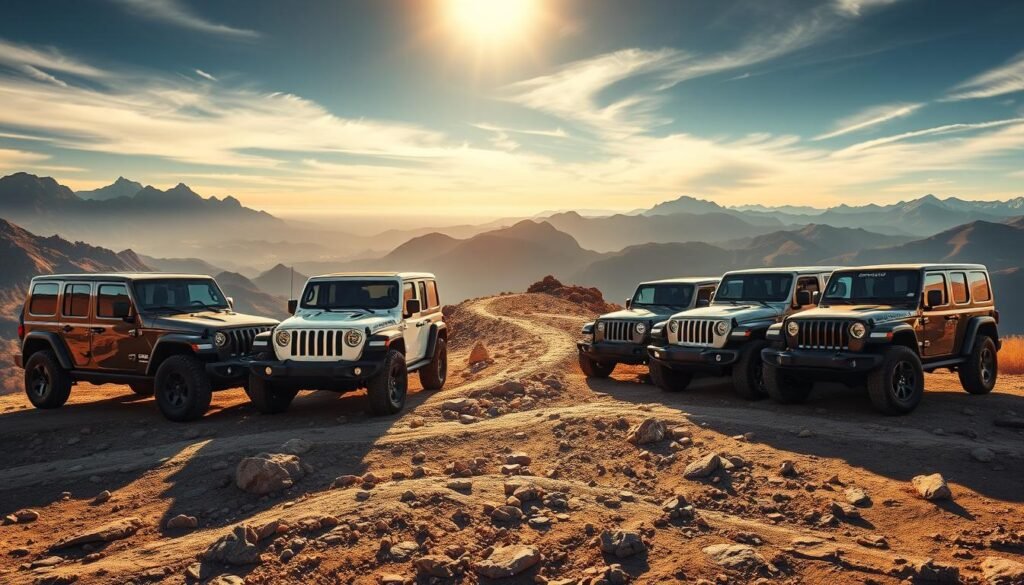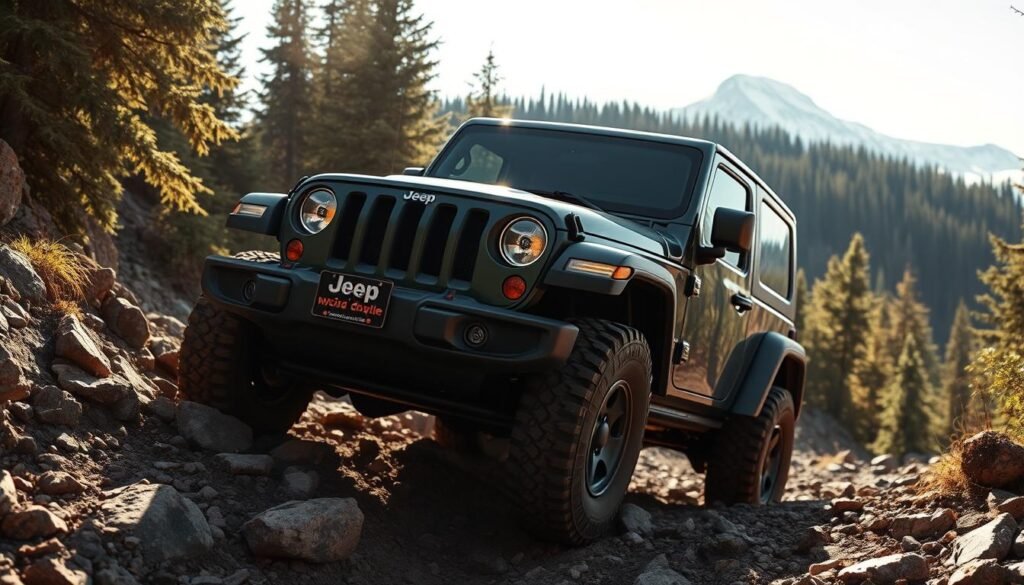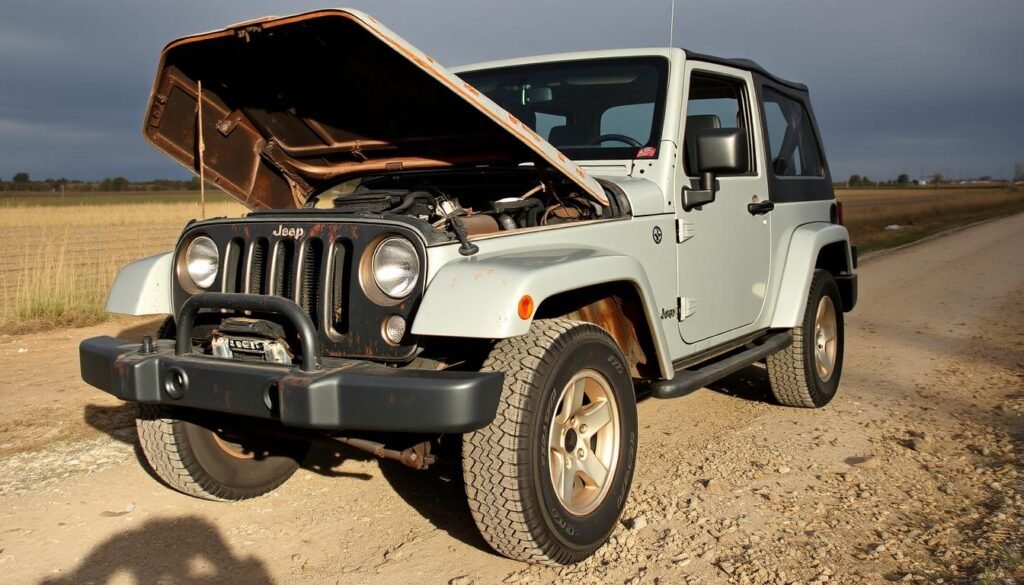The Jeep Wrangler’s durability is legendary among off-road enthusiasts and everyday drivers. A well-maintained Wrangler can last between 200,000 to 400,000 miles. This means it can serve you for 15 to 20 years.
Potential owners often wonder about the true longevity of these iconic vehicles. The answer lies in engineering and how well you care for and drive it. Jeep Wranglers can handle city streets and mountain trails with remarkable resilience.
Whether you’re an adventure seeker or a practical driver, knowing a Jeep Wrangler’s lifespan is key. This guide will explore every aspect of Wrangler durability. You’ll learn what makes these vehicles last so long.
Jeep Wrangler’s Expected Lifespan
Jeep Wranglers are known for their durability and long life. These rugged vehicles can handle tough conditions. They are perfect for those who love adventure and daily driving.
Average Longevity Statistics
Jeep Wrangler mileage is impressive. A well-kept Wrangler can last from 200,000 to 300,000 miles. Some owners have even gone over 300,000 miles. These vehicles can last 15 to 20 years, much longer than many others.
Factors Affecting Vehicle Duration
Several things affect a Wrangler’s life:
- Maintenance Frequency: Regular servicing is key
- Driving conditions (highway vs. off-road)
- Quality of repairs and replacement parts
- Individual driving habits
Typical Mileage Benchmarks
Knowing what affects a Wrangler’s life helps owners get the most out of it. High-mileage for Jeep Wranglers starts around 150,000 miles. This is much higher than the 100,000 miles for many other cars. With the right care, some Wranglers can go over 300,000 miles.
“A Jeep Wrangler isn’t just a vehicle, it’s an investment in long-lasting adventure.”
The Impact of Regular Maintenance on Wrangler Durability

Keeping your Jeep Wrangler in top shape is more than just cleaning it. It’s about making sure it lasts longer and runs better. By following a proper maintenance routine, you can extend your Wrangler’s life by up to 25%. This turns a great vehicle into an amazing one.
There are key maintenance tasks that are essential for keeping your Wrangler in good condition. Here are the most important ones:
- Regular oil changes every 5,000 to 7,500 miles
- Tire rotations and alignment checks
- Comprehensive vehicle tune-ups
- Brake system inspections
Regular care can help your Wrangler go far. Many owners have theirs reach over 200,000 to 300,000 miles with the right maintenance.
| Maintenance Task | Recommended Frequency | Impact on Lifespan |
|---|---|---|
| Oil Changes | Every 5,000-7,500 miles | Critical for engine health |
| Tire Rotation | Every 5,000 miles | Ensures even wear |
| Comprehensive Tune-up | Every 30,000 miles | Prevents major system failures |
Regular maintenance for your Jeep Wrangler is more than just avoiding breakdowns. It’s about keeping your vehicle running well and holding its value. The right care can turn your Wrangler into a long-lasting adventure partner.
How Many Miles Does A Jeep Wrangler Last: Real-World Examples
Looking into real-world Jeep Wrangler longevity shows us amazing facts. Wrangler longevity examples show how these vehicles last long, no matter the driving conditions or model year.
Highway vs Off-road Usage Impact
How you drive your Jeep Wrangler affects its life span. Cars driven mostly on highways can go over 300,000 miles with good care. But, those used off-road might reach around 200,000 miles, due to tougher terrain.
- Highway driving: Smoother surfaces reduce mechanical stress
- Off-road usage: More demanding on vehicle components
- Maintenance frequency plays a key role in Jeep Wrangler high mileage
Model Year Variations
Each Wrangler generation has its own longevity story. Newer models get better engineering and manufacturing.
| Model Year | Average Lifespan | Notable Features |
|---|---|---|
| 2007-2018 (JK) | 250,000-300,000 miles | Improved reliability |
| 2018-Present (JL) | 300,000-350,000 miles | Enhanced durability |
Maintenance Schedule Effects
Regular maintenance is key to a Jeep Wrangler’s long life. Keeping up with oil changes, repairs, and following the maker’s advice can help your vehicle hit high mileage marks.
Proper care turns a good Jeep Wrangler into an amazing long-lasting vehicle.
Common Issues That Affect Jeep Wrangler Longevity
Jeep Wrangler problems can really hurt its durability and performance. Knowing these common issues helps owners keep their vehicles running longer.
The most common Wrangler problems include:
- Death Wobble: A severe steering wheel vibration that can occur at higher speeds, typically caused by worn suspension components
- Transmission failures, often seen in older models
- Electrical system malfunctions
- Persistent oil leaks
- Rust and corrosion problems
Jeep Wrangler problems can show up at different mileage points. Some issues get worse as the vehicle gets older. The most important parts to watch include:
| Component | Common Issue | Typical Mileage of Occurrence |
|---|---|---|
| Suspension | Ball Joint Wear | 100,000-150,000 miles |
| Transmission | Shifting Problems | 80,000-120,000 miles |
| Electrical System | Module Failures | 70,000-100,000 miles |
Regular maintenance is the best way to avoid these problems. By doing regular checks, fixing things quickly, and solving small issues early, you can make your Jeep Wrangler last longer.
Early detection and professional diagnosis are key to preventing costly repairs and maintaining your Wrangler’s performance.
Comparing Different Wrangler Generations’ Durability
Jeep Wrangler generations have changed a lot over time. Each one has brought new improvements in durability and performance. Knowing the differences helps buyers choose the best for long-term use.

The Jeep Wrangler has seen big changes through its generations. These changes have made the Wrangler more reliable and long-lasting.
JK Generation (2007-2018)
The JK generation was a big step for the Wrangler. Early models (2007-2011) scored 6/10 in reliability. Later models (2012-2018) got a better score of 7.5/10. Key features include:
- Powered by a 3.6L Pentastar V6 engine
- 285 horsepower and 260 lb-ft of torque
- Improved build quality compared to previous generations
JL Generation (2018-Present)
The JL generation took the Wrangler to new heights. Early models got an 8/10 reliability rating. Recent models (2021-2024) scored an impressive 8.5/10.
- Introduced the 4xe Plug-In Hybrid model
- Total hybrid output of 375 horsepower
- All-electric range up to 25 miles
TJ Generation (1997-2006)
The TJ generation was an early step in the Wrangler’s evolution. It set the stage for future improvements. These models were known for their strong design and off-road skills.
Many Jeep Wrangler owners have gone over 200,000 miles with good care. This shows the brand’s dedication to durability through the years.
Maximizing Your Jeep Wrangler’s Lifespan Through Proper Care

To make your Jeep Wrangler last longer, you need to take good care of it. Following some simple care tips can help you avoid expensive repairs. By keeping up with maintenance, you can make your Wrangler last for many years.
Here are some important steps to keep your Wrangler in top shape:
- Regular Oil Changes: Change the oil every 3,000-5,000 miles to keep the engine running smoothly
- Routine Tire Rotations: This ensures your tires wear evenly and work well
- Comprehensive Suspension Checks: This helps avoid the dreaded death wobble
- Timely Transmission Fluid Replacements
- Consistent Wheel Alignments
Fixing small problems early can save you a lot of money later. It’s smart to set aside money for regular maintenance. With the right care, your Jeep Wrangler can easily go over 200,000 miles.
Preventative maintenance is the key to extending your Jeep Wrangler’s life and performance.
It’s important to check the suspension, steering, and drivetrain regularly. This helps catch problems before they get worse. Pay close attention to:
- Suspension component tightness
- Steering system integrity
- Brake system condition
- Electrical system diagnostics
By following these care tips, you can make your Jeep Wrangler last longer. With consistent care, your Wrangler becomes a trusted friend for many adventures.
Critical Components That Determine Wrangler’s Longevity
Jeep Wranglers are known for their durability. Key parts play a big role in how long they last. Knowing these parts helps owners keep their Wranglers running well for years.
The engine, transmission, and suspension are key to a Wrangler’s long life. Each needs regular care to work its best.
Engine Health Indicators
The engine is the heart of a Wrangler’s durability. Owners should keep an eye on these signs:
- Regular oil changes every 5,000 to 7,500 miles
- Monitoring coolant levels and quality
- Checking for unusual noises or performance changes
- Maintaining consistent engine tuneups every 30,000 miles
Transmission Durability
The transmission is key to a Wrangler’s long life. Proper care can extend its life well beyond 200,000 miles. Here’s how to keep it in top shape:
- Regular fluid checks and changes
- Avoiding aggressive driving patterns
- Addressing any shifting irregularities immediately
- Professional inspections during scheduled maintenance
Suspension System Longevity
A strong suspension system is vital for Wrangler performance, off-road or on. Keeping it up involves:
- Regular wheel alignment checks (every 6-12 months)
- Inspecting shock absorbers and springs
- Addressing unusual ride characteristics promptly
- Protecting undercarriage from rust and corrosion
By taking care of these key parts, Wrangler owners can make their vehicle last up to 300,000 miles. This ensures it stays reliable and performs well.
Signs That Your Jeep Wrangler Is Nearing Its End
Knowing when your Jeep Wrangler is nearing its end can help you plan. Look for signs of wear and tear. These can tell you it’s time to think about getting a new one.
Experienced Wrangler owners should watch for critical warning signs. These signs show that your vehicle is nearing its end:
- Persistent death wobble at highway speeds (around 55-60 mph)
- Recurring transmission control module (TCM) failures
- Extensive rust damage on critical structural components
- Frequent and expensive repair requirements
Critical mechanical issues can shorten a Wrangler’s life. Here are some alarming statistics:
| Issue | Frequency | Severity |
|---|---|---|
| Death Wobble | 33% occurrence rate | High |
| Fuel System Problems | Multiple reports at 76,000 miles | Moderate to High |
| Transmission Issues | Thousands of affected vehicles | Critical |
When checking if your Wrangler is nearing its end, look for:
- Increasing repair costs that are more than the vehicle’s value
- Structural integrity compromises
- Safety-related mechanical failures
- Consistent performance degradation
Understanding these warning signs helps Jeep Wrangler owners make smart choices. They can decide when to maintain or replace their vehicle before major problems arise.
Buying a High-Mileage Jeep Wrangler: What to Consider
Buying a used Jeep Wrangler needs careful thought, more so for high-mileage ones. “High mileage” for a Wrangler means over 150,000 miles. Yet, a well-kept Wrangler can be reliable and perform well.
- Comprehensive maintenance history
- Detailed inspection of critical components
- Signs of previous off-road usage
- Potential repair and replacement costs
Here are key areas to check in a used Jeep Wrangler:
| Component | Inspection Focus |
|---|---|
| Transmission | Check for smooth shifting, specially in 2007-2011 models |
| Engine | Look for oil cooler failures after 2014 |
| Suspension | Evaluate wear from off-road use |
“A thorough professional inspection can save thousands in future repairs,” experts say.
Despite challenges, a high-mileage Jeep Wrangler can be a smart buy. The best Wranglers can go up to 280,000 miles with good care. Look for vehicles with service records and little wear.
Before buying a used Jeep Wrangler, always:
- Get a full vehicle history report
- Book a professional mechanical check
- Test drive it in different conditions
- Check for recalls with the VIN
Conclusion: The Long-Lasting Legacy of Jeep Wranglers
The Jeep Wrangler is a symbol of top-notch car durability. It can go over 200,000 miles, showing it’s more than just a ride. It’s a legacy of toughness.
Its long-term value comes from smart design and strong engineering. From early JK models to the latest JL, it keeps getting better. With regular care, it stays reliable on all kinds of roads.
Knowing how to keep a Wrangler running well is key. It’s not just a car; it’s a quality choice for adventure. It’s a lasting symbol of excellence in American cars.
Whether you’re driving on mountains or city streets, the Jeep Wrangler stands out. Its tough design, steady performance, and flexibility make it a favorite for many.
FAQ
How many miles can a Jeep Wrangler typically last?
A Jeep Wrangler can go from 200,000 to 400,000 miles with the right care. Many owners see their Wranglers last over 250,000 miles. This is thanks to its strong build and durability.
What maintenance is key for a Wrangler’s long life?
Keeping up with regular maintenance is essential. This includes oil changes, tire rotations, and fluid checks. Also, don’t forget brake inspections and fixing small problems quickly. Sticking to the manufacturer’s schedule helps keep your Wrangler reliable for years.
Do different Wrangler generations have different longevity?
Yes, each Wrangler generation has its own traits. The TJ (1997-2006) is simple, the JK (2007-2018) is more reliable, and the JL (2018-present) is advanced. Each has its own strengths in durability and lifespan.
What are common issues that might impact a Wrangler’s longevity?
Issues like the “death wobble” in suspension and transmission problems can occur. Electrical system issues and rust in older models are also common. Catching these early and getting professional help can help avoid big problems.
How does driving style affect a Jeep Wrangler’s lifespan?
Driving style greatly affects a Wrangler’s life. Off-roading can wear it down faster, while highway driving is easier. Driving gently and avoiding extreme conditions, along with regular maintenance, can help your Wrangler last longer.
What should I look for when buying a high-mileage Wrangler?
Look at the maintenance history and check the frame, suspension, and engine. Watch for rust and have a mechanic inspect it before you buy. This ensures you’re getting a good deal.
Are Jeep Wranglers more durable than other SUVs?
Wranglers are known for their toughness, inspired by military vehicles. Their body-on-frame design and simple mechanics make them last longer than many SUVs. Plus, they have a strong aftermarket support.
How can I tell if my Wrangler is nearing the end of its serviceable life?
Look for signs like more frequent repairs, rust, and major mechanical issues. If performance drops and repair costs get too high, it might be time to think about getting a new one.


